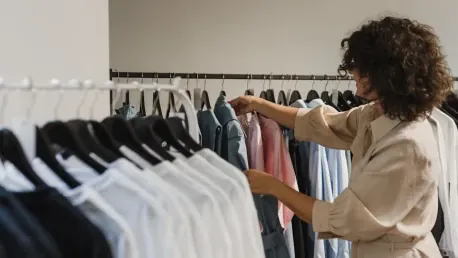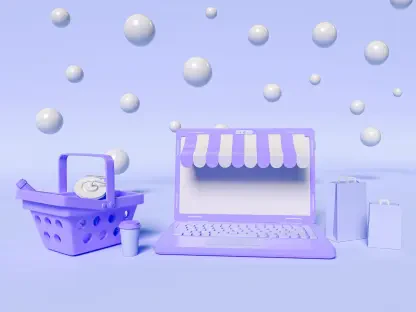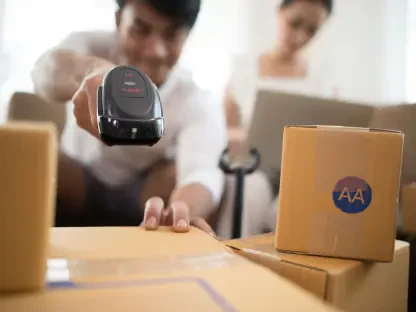The integration of augmented reality (AR) into the fashion retail industry has revolutionized the way consumers shop for clothes and accessories. This innovative technology not only enhances the shopping experience but also drives sales and helps fashion retailers achieve their business objectives. Despite being relatively new, AR has shown significant potential in transforming the fashion landscape. The intersection of technology and fashion has created novel opportunities that enable shoppers to interact with brands in ways that were previously unimaginable. AR has introduced a dynamic shift in how customers perceive and purchase fashion items.
Introduction to AR in Fashion Retail
Augmented reality (AR) has captured the imagination of consumers and retailers alike. By superimposing virtual content over the real-world environment, AR offers an engaging and pleasurable shopping experience. According to a report from Deloitte, 71% of shoppers are likely to shop more frequently using AR-powered apps, and 40% of consumers are willing to pay more if they can test a product in AR. This write-up explores how AR technologies are being used in fashion retail to enhance customer experiences and drive business outcomes. AR’s ability to revolutionize retail by offering immersive and interactive modes underscores its growing significance in enhancing the traditional shopping experience.
Recognizing AR’s potential, fashion retailers have embraced this technology to provide innovative shopping solutions. Augmented reality bridges the gap between virtual and real, allowing customers to access an array of features that bring the best of online and in-store shopping into a single experience. The ease with which customers can test out fashion items without the constraints of physical stores or traditional fitting rooms addresses longstanding challenges in the retail industry. As technology continues to evolve, the synergistic effect between AR advancements and customer expectations drives the broader adoption of this transformative tool.
Understanding Augmented Reality
Augmented reality (AR) superimposes virtual content over the real-world environment using smartphones or other electronic devices. Unlike virtual reality (VR), which immerses users in a completely computer-generated environment, AR allows virtual objects to coexist with the real world as captured by a device’s camera. This technology has found a unique application in fashion retail, where it is commonly implemented as Virtual Try-On (VTO). The capacity to integrate digital elements seamlessly into real-life settings empowers fashion retailers to present their collections innovatively and interactively.
The emergence of AR has reshaped consumer expectations and finite interactions by making digital overlays a tangible extension of reality. Augmented reality in fashion retail increases engagement by allowing shoppers to explore a brand’s collection with an unprecedented level of interaction. The convergence of physical and digital realms opens up broader possibilities, making the shopping experience more personalized, convenient, and enjoyable. As AR technology becomes more sophisticated, its application in fashion retail is expected to grow, strengthening customer relationships and enhancing the overall shopping experience.
Virtual Try-On (VTO) in Fashion Retail
In fashion retail, Virtual Try-On (VTO) allows customers to virtually wear or sample clothes, accessories, makeup, and other personal effects. VTO uses AR technology to superimpose a virtual representation of a product over the customer’s image, helping them visualize how items would look or fit. There are two primary methods for VTO: using personal devices and virtual fitting rooms. This versatility in implementation provides customers with numerous options, be it at home or in physical stores, enhancing their overall shopping experience no matter their preference.
Customers can use their smartphones, tablets, desktops, or laptops to access the retailer’s AR-enabled digital platform through an app or web browser. This method allows customers to try on products from the comfort of their homes, providing a convenient and personalized shopping experience. The use of personal devices for VTO has become increasingly popular, especially during the pandemic when in-store shopping was limited. Shoppers appreciate the flexibility, which has contributed to a growing reliance on AR technology for making informed purchasing decisions.
Personal Devices for Virtual Try-On
Customers can use their smartphones, tablets, desktops, or laptops to access the retailer’s AR-enabled digital platform through an app or web browser. This method allows customers to try on products from the comfort of their homes, providing a convenient and personalized shopping experience. The use of personal devices for VTO has become increasingly popular, especially during the pandemic when in-store shopping was limited. Shoppers appreciate the flexibility, which has contributed to a growing reliance on AR technology for making informed purchasing decisions.
The convenience of VTO on personal devices cannot be overstated. Customers can now visualize how various items will look without stepping foot into a store, eliminating the trial-and-error associated with traditional shopping methods. It not only saves time but also enhances the decision-making process, leading to higher customer satisfaction and loyalty. Retailers, in turn, benefit from reduced return rates and increased sales as customers feel more confident and informed about their purchases.
Virtual Fitting Rooms
Virtual fitting rooms use digital mirrors and smart displays to provide an immersive AR experience. Customers can interact with AR technology in-store, trying on clothes and accessories without physically wearing them. This method not only enhances the shopping experience but also reduces the need for physical inventory, making it a cost-effective solution for retailers. Virtual fitting rooms are transforming brick-and-mortar stores into tech-savvy spaces that leverage digital innovation to attract and retain customers.
In-store virtual fitting rooms bring a new dimension to retail environments, making them interactive and modern. Shoppers engage with digital mirrors or smart displays, receiving real-time feedback on how various items fit and look. This interaction adds a layer of excitement and intrigue, drawing customers to the store and encouraging frequent visits. The reduction in physical inventory requirements allows retailers to allocate resources more efficiently, focusing on enhancing the overall shopping experience rather than merely managing stock levels.
Notable Examples of AR in Fashion Retail
Several leading fashion brands have effectively deployed AR to enhance the shopping experience. Here are some notable examples:
H&M: Get Dressed in the Metaverse
H&M launched its first virtual clothing line in January 2022 through a competition inviting creative names for the featured looks. Winners could “try on” virtual pieces by submitting their photos, which were then styled into animated images by 3D graphic designers for sharing on social media. This foray into digital fashion lets H&M connect more creatively and entertainingly with customers using advanced 3D and animation design software. By leveraging AR, H&M has found novel ways to engage with customers, providing a unique experience that merges fashion with technology.
The introduction of a virtual clothing line enabled H&M to tap into the growing trend of digital fashion, where virtual garments offer a new playground for creativity and expression. Customers can enjoy the versatility of virtual wardrobe trials, fostering a sense of community and engagement around H&M’s digital offerings. The successful implementation of AR in this context underscores H&M’s commitment to staying at the forefront of technological advancements, enhancing customer interaction, and remaining relevant in an ever-evolving market.
Burberry: Elevating Brand Experience with AR
Burberry has adopted AR across various online channels, collaborating with Google to bring in-store experiences to online shoppers. Products like the Black TB bag and Arthur Check Sneaker were viewable in 3D on Google, extending their reach and enhancing customer expectations through realistic product views. Additionally, Burberry’s AR initiatives have supported global marketing campaigns, such as collaborating with artist Danny Sangra to create “Burberry-inspired” AR drawings. Burberry’s strategic use of AR has cemented its position as a forward-thinking brand, providing customers with innovative ways to experience luxury fashion.
The collaboration with Google allowed Burberry to showcase products in a lifelike manner, bridging the gap between online shopping and the sensory experience of physical stores. Customers could explore products in three dimensions, leading to more informed purchasing decisions. Burberry’s AR marketing campaigns also added an artistic and interactive element, aligning with the brand’s image of innovation and creativity. These efforts have not only enhanced the shopping experience but also contributed to higher customer engagement and loyalty.
Zalando: Try-On
Germany’s leading online fashion retailer, Zalando, introduced a virtual dressing application called “Try On” on Snapchat. Users take a full-body photo and upload it within the app to try on selected products from Zalando’s brands. The technology integrates chosen garments into the photo, mimicking the appearance of the wearer. This feature saw significant engagement during collaborations with brands like Puma and Anna Field. Zalando’s implementation of AR via social media platforms like Snapchat reflects its commitment to meeting customers where they are and enhancing their digital shopping journey.
The seamless integration of AR into social media provides a natural extension of users’ daily activities while introducing new avenues for brand interaction. Zalando’s “Try On” application not only enhances user experience but also serves as a powerful marketing tool that capitalizes on social media’s expansive reach. The collaborations with renowned brands like Puma and Anna Field have bolstered users’ engagement, further demonstrating AR’s potential to drive sales and customer interest.
Lily: Virtual Fitting Room in Non-Store Locations
For a pop-up campaign, Lily installed smart mirrors powered by VTO at a Shanghai metro station, allowing commuters to virtually try on clothes in real time. Entering their height and weight, users could see digital clothing overlaid on their selfies. The mirrors generated QR codes enabling users to download their images. This high-foot-traffic initiative gave commuters an immersive experience, introducing them to Lily’s collection without visiting a store. Using AR technology in public spaces broadens the reach of fashion brands, creating more touchpoints for customer engagement.
By placing virtual fitting rooms in non-store locations, Lily has effectively brought the shopping experience to where customers are. This strategy not only garners attention but also creates buzz around the brand, expanding its visibility and appeal. The interactive nature of VTO via smart mirrors offers a memorable and engaging experience, fostering a connection between customers and the brand. The ability to download images enables ongoing interaction, furthering brand exposure and customer interest.
Fendi: Maintaining Relationships Through Virtual Dressing Rooms
Amid the pandemic, Fendi maintained connections with loyal clients through virtual dressing rooms equipped with high-quality cameras for better product visualization. Advisors engaged clients via live video, fitting clothes for them to see. Clients could invite friends to join, mimicking in-store experiences. The AR-enabled tool helped client advisors create multiple looks for clients, enhancing the interactive shopping experience. Fendi’s adaptation of AR to strengthen customer relations during challenging times showcases the technology’s versatility and potential.
The virtual dressing rooms allowed Fendi to uphold a high level of service and personalization, even when physical interactions were limited. This continuity ensured that customers remained engaged and loyal to the brand, despite the disruptions caused by the pandemic. The AR technology provided a platform for connection and interaction, mirroring the in-store experience as closely as possible. It emphasized the importance of innovation in maintaining customer relationships and enhancing the overall shopping journey.
Adidas: Highlighting Sustainability with AR
In 2019, Adidas introduced a footwear try-on feature in its iOS app, and later on Android, allowing customers to virtually try on iconic and running shoe models. While size accuracy wasn’t present, it showed users how shoes looked before purchase. Additionally, Adidas used AR in pop-up campaigns to highlight sustainability, like showcasing recycled plastic conversion into footwear through gamified mobile AR experiences. Campaigns across European locations featured QR codes triggering AR experiences to highlight sustainable materials in Adidas Stan Smith shoes. Adidas’s use of AR exemplifies how brands can leverage technology to promote sustainability while engaging with customers on innovative platforms.
The AR try-on feature allowed customers to explore Adidas’s footwear collection interactively, enhancing the shopping process. By incorporating sustainability themes into AR experiences, Adidas educated customers about their eco-friendly initiatives, aligning with growing consumer interest in sustainable products. These interactive and educational campaigns not only highlighted Adidas’s commitment to the environment but also engaged customers in meaningful and memorable ways, fostering brand loyalty.
Benefits of AR in Fashion Retail
AR offers a fun and engaging way for customers to try on clothes and accessories. It encourages them to experiment with new trends and provides hyper-personalized experiences through tailored recommendations. The immersive nature of AR technology creates an interactive shopping experience that is both entertaining and practical, drawing customers in and encouraging them to explore more products. This heightened engagement often translates to increased spending and loyalty, as customers feel a stronger connection to brands that invest in innovative solutions.
Additionally, AR in fashion retail can significantly increase revenue. Customers using AR apps are 19.8% more likely to make a purchase. Strategically employing AR in sales funnels can increase store sales by easing the browsing process, whether online or in-store. The enhanced visualization of products leads to more confident purchasing decisions, reducing the likelihood of returns and enhancing overall customer satisfaction. Retailers benefit from increased sales volume and the efficiencies gained through reduced return rates, making AR a valuable investment in the retail ecosystem.
Is AR a Game Changer or Hype?
The incorporation of augmented reality (AR) into the fashion retail sector has dramatically transformed the way consumers shop for clothing and accessories. This cutting-edge technology not only elevates the shopping experience but also boosts sales and assists fashion retailers in meeting their business goals. Though AR is a relatively recent innovation, it has already demonstrated substantial potential in reshaping the fashion industry.
The convergence of technology and fashion has opened up innovative opportunities, allowing shoppers to interact with brands in ways previously unimaginable. With AR, customers can now virtually try on clothes and accessories, visualize how they will look without ever stepping into a store, and make more informed purchasing decisions. This technology has introduced a dynamic shift in customer perception and purchasing behavior, making shopping more engaging and personalized.
Furthermore, AR can reduce return rates by letting customers see the fit and style of an item before buying, which saves both time and money for retailers and consumers alike. Retailers can also use AR to create immersive marketing campaigns that capture customers’ attention, making their brands stand out in a crowded market. In essence, AR is not just a gimmick; it’s a powerful tool that enhances the overall shopping experience and drives the fashion industry forward into a new era.









